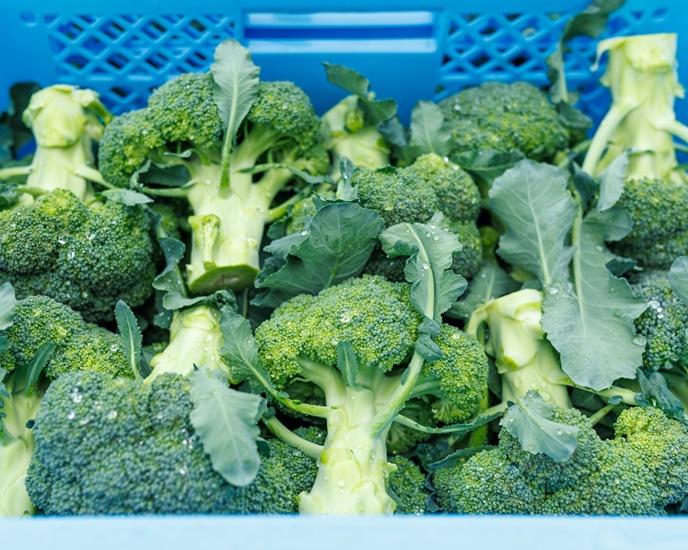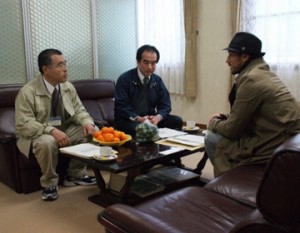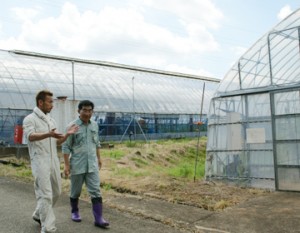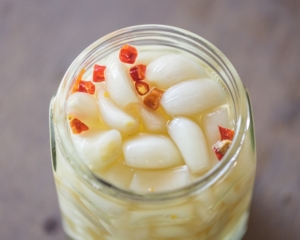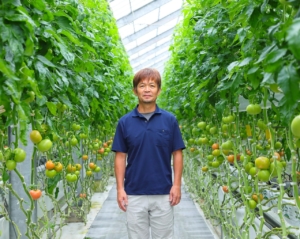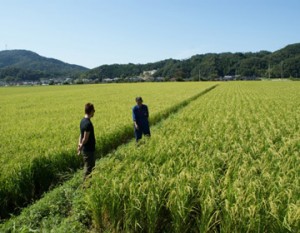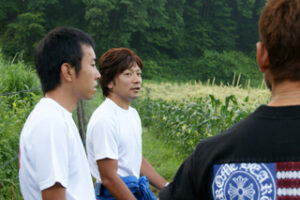Daisen Broccoli” has a strong sweet taste and little bitterness. It is the pride of Oyama Town, which boasts the largest area planted in western Japan. Masayuki Hayashibara, president of andAgri Co., Ltd. is working hard to promote Oyama broccoli, following in the footsteps of his predecessor who contributed to the establishment of the brand.
Rich soil nurtured by Tottori’s famous mountain “Daisen

Daisen Town in Tottori Prefecture is a town rich in nature, with the Sea of Japan to the north and Mount Daisen, the highest peak in the Chugoku region, to the south. From the sea to the foot of Mt. Daisen is only about 20 minutes by car, making it an environment where one can enjoy the bounty of both the sea and the mountains. The fields extend from the coastal area at an elevation of 0 m to the semi-cool area at an elevation of approximately 600 m. Because of its location at the foot of the mountain, there is a large difference in temperature between daytime and nighttime. In addition, the black soil from the volcanic ash of Mt. Daisen is rich in organic matter and well drained, making it ideal for broccoli cultivation.
History of Oyama Broccoli
Broccoli cultivation began in Oyama Town around 1970. Until then, the town’s main crop had been rice to increase the rice harvest, but as rice became scarce, the town had to grow other crops. At that time, they turned their attention to broccoli. The black soil of Mt. Daisen, the temperature difference between day and night, and the abundance of water made broccoli cultivation a perfect fit. Broccoli cultivation was a perfect fit.
However, as they began to grow one type of crop in the same area in an effort to increase efficiency, they gradually developed continuous cropping problems (i.e., the nutrients in the soil become unbalanced as they continue to grow the same crop), and they struggled to cope with the problems. In fact, rice cultivation in the rice paddies that had been practiced until then did not cause continuous crop failure because the water had a variety of nutrients, so the nutrients in the soil were less biased.
Furthermore, cultivation gradually slowed down, affected by the increase in imported crops.
It was Masayuki’s father, Hiroshi, who moved to reform the situation.
Rebuilding the brand through quality control

In order to differentiate broccoli from imported products and create a unique Oyama characteristic, we set about improving the shipping method. Broccoli loses its freshness from the moment it is harvested, and the leaves wilt, so imported products do not have leaves on them. In order to show that broccoli is fresh, we began shipping it with the leaves attached for the first time in Japan. In addition, freshly harvested broccoli is wrapped in freshness-preserving film and vacuum-pre-cooled before shipment to maintain freshness. In addition, the company is also using its experience in cultivation to provide guidance to new farmers. They have also established a system to ensure that producers in the Daisen area can ship their products with the same quality.
Their efforts bore fruit in 2012 when they obtained a “regional collective trademark,” and in 2018 they were registered as “Daisen Broccoli®” under the government’s “Geographical Indications System,” commonly known as GI. The characteristics of this product are its sweetness and low bitterness, thorough quality control, and the fact that it can be grown almost year-round by taking advantage of the fields at various elevations in the town, enabling a stable supply to the market. The town boasts the largest planted area in western Japan by municipality, and the Daisen broccoli brand has become widespread.
Establishment of “andAgri” to connect traditions and producers’ thoughts

His son, Masayuki, followed in the footsteps of Hirotoshi, who made a major contribution to the acquisition of the GI certification. With his sights set on becoming a broccoli farmer, after graduating from college he gained experience in logistics and sales at a local fruit and vegetable market, and started farming at the age of 29. Furthermore, two years later, in 2019, he established andAgri, Inc. He increased the area of his farm from the original 7 hectares to more than 50 hectares to achieve more stable cultivation.
The company’s name “and” means “connecting” and “agri” means “agriculture. We are here today because of the traditions of this region and the history of the producers. We did not forget them, and we wanted to connect them to the future.
Daisen Broccoli Cultivation in Harmony with Nature
There are many varieties of broccoli, ranging from the early variety, which can be harvested in three months, to the late variety, which takes six months or more. andAgri has 10 to 15 varieties that can be harvested almost year-round, except for August and September, when it is in midsummer. Masayuki recommends the medium-early “Keirin” variety, which has firm, crisp buds. He is also working on varieties with different textures and sweetness, such as “Kirakira Midori,” which uses 70% less chemical fertilizer than normal cultivation and has less bitterness and bitterness, and “Sweet Broccoli,” which has a sugar content of about 12 degrees and is characterized by its fruit-like sweetness.
Broccoli has the advantage of being easier to rotate than other vegetables because it can be harvested in a short period of time, but it is also more difficult because it is grown in the open, without the use of plastic greenhouses.
The winds blowing from the Sea of Japan are strong, and in coastal fields, we have to consider the effects of salt damage. There are also typhoons and snowfalls, so it is important to plan which fields, when, and which varieties to plant. Daily observation is also essential,” he says, “by watching the growth of each broccoli closely, applying additional fertilizer, and gathering soil.
The hard work behind the harvest and the secret of its delicious taste

In fact, what we usually eat is a collection of buds of broccoli before the flowers bloom. If they grow beyond the size suitable for shipping, yellow flowers like rape blossoms will bloom. The optimum harvest period for early summer picking is two to three days, so harvesting must be completed within this period.
However, in order to maintain freshness for shipping, harvesting must be done during cooler temperatures, usually between 10:00 p.m. and 9:00 a.m. In addition, even if the same variety is planted in one field at the same time, there are individual differences in growth, and it is not possible to harvest all at once. It is also difficult to secure the necessary manpower, as the farmers need to check the growth of each crop every day to see if it is big enough to be shipped, and harvest it by hand.
We have prospective farmers who come to our farm, but when they experience harvesting, they often say, ‘It’s harder than I thought it would be. It is true that it is not something that is easy to do physically. Even so, it is very rewarding when they produce the broccoli they had envisioned. That is why we are also making efforts to create an environment where young people can work with ease, by discussing cultivation conditions with the team and sharing know-how from local growers,” he says.
How to Eat Tasty Broccoli

Broccoli is highly nutritious, containing vitamins A and C, dietary fiber, and potassium. When purchasing broccoli at the supermarket, it is best to select broccoli with firm, tight buds, as shown in the photo of broccoli buds above. Don’t forget to check the cut ends of the stems, as white ones are not as fresh as they should be.
Once purchased, broccoli can be cut into bite-size pieces and frozen for freshness at any time.
Broccoli that appear in the spring are those that were sown in the fall. The broccoli that comes out in the spring are sown in the fall, so they are sweeter after the harsh winter in the San’in region, so be sure to compare them.
Broccoli recipes that go beyond boiling

Broccoli is often boiled and eaten with mayonnaise, but we were also given a recipe directly from a farmer. The first one is “Shrimp, salted kelp and broccoli salad. In a frying pan, dry-roast small shrimps until fragrant. Then, add boiled broccoli and mix with sesame oil and salted kelp. This dish is perfect as a side dish or snack.
Broccoli fritters” are made by dipping hard-boiled broccoli in pancake mix and deep frying. You can enjoy the sweetness of the broccoli as it is, or it goes great with ketchup or mayo soy sauce. This recipe is also popular with children because it can be used as a snack.
Furthermore, if you roast broccoli raw in the oven, you can enjoy its rich flavor without losing any of its nutritional value and sweetness.
There are actually many varieties of broccoli, with varying degrees of firmness, texture, and boiling time. However, at present, broccoli is only known as “broccoli,” and it is difficult to tell the difference in flavor depending on the variety and harvest time. In the future, I would like to go one step further and convey the appeal of broccoli,” says Masayuki. Masayuki plans to focus on information dissemination from producers.
I want to challenge myself without setting limits.
In broccoli cultivation, which deals with nature, there is no standard that says, “If you do it this way, it will definitely work. Even if you grow broccoli at the same time and under the same conditions, the results can vary greatly. That is why it is so exciting to see the delicious broccoli you have always wanted to grow. It is also interesting to know why the results are so different, and to be able to improve on them through trial and error with your friends, saying, “Let’s do this next year.
In Oyama Town, farmers are aging, and the number of farmers who have left farming and vacant farmland is increasing. We would like to be on the receiving end of these people and support the local community so that the farmland is not destroyed. I also want to challenge myself without setting any goals or limits for myself as to ‘how far I can go as a broccoli farmer. I would also like to communicate to consumers that Oyama broccoli is not just broccoli, but that it is valuable because it is Oyama broccoli.



